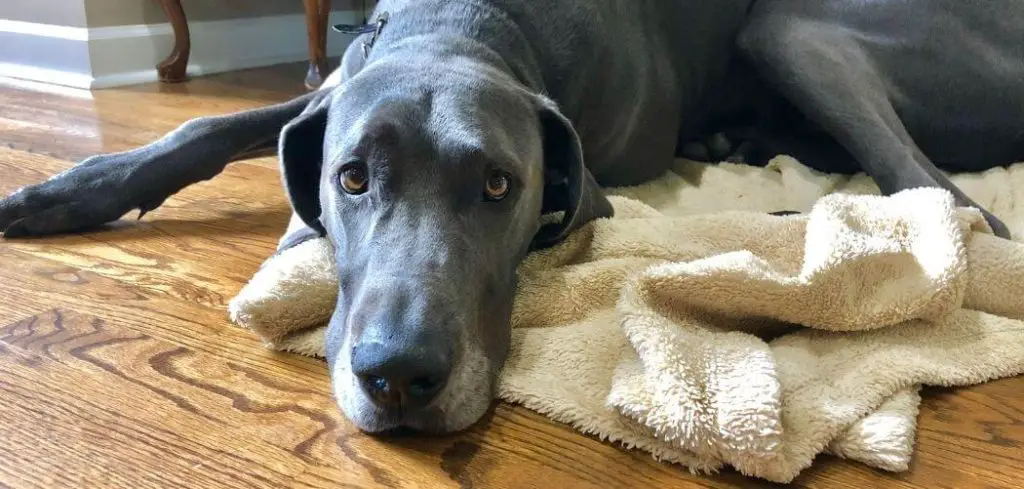Seeing your dog panting and crying after surgery can be distressing for any dog parent. While some level of discomfort and restlessness is expected during recovery, ongoing panting combined with crying may signal pain or complications that require attention.
We outline the common causes of panting and crying after surgery in dogs, what you can do, and when to seek veterinary help.
Table of Contents
Dog Panting and Crying After Surgery — Why It Happens
Dogs may pant and cry after surgery due to pain, anesthesia side effects, stress, or medical complications. Panting is often the body’s response to discomfort, stress, or changes in temperature, while crying or whining can indicate distress or pain.
Sometimes, the combination may be temporary and linked to anesthesia wearing off, but it can also signal that your dog needs additional care or medical support during recovery.

Dog Panting and Crying After Surgery: Common Causes
Post-Surgical Pain
Pain is one of the most common reasons a dog pants and cries after surgery. Even with prescribed pain medication, some dogs may still feel discomfort at the incision site or in the muscles affected during the procedure.
Panting helps dogs cope with pain, while crying or whining signals their distress.
If pain is not well controlled, your dog may also appear restless, avoid lying down, or refuse to eat. Proper pain management is crucial for smooth healing.
Read more: Dog Panting and Clicking Eyes (What it means)
Anesthesia Side Effects
After surgery, dogs may experience lingering effects of anesthesia. Disorientation, nausea, and restlessness are common, and these can lead to panting and vocalization.
Some dogs feel confused or anxious as they wake up, causing them to cry out even if they are not in severe pain.
Usually, these effects fade within 24 hours, but if panting and crying continue, it may suggest other complications.
Stress and Anxiety
Surgery is a stressful experience, and the recovery environment can heighten a dog’s anxiety.
Being in an unfamiliar place, wearing a cone, or being separated from their usual routines can all contribute to stress.
Panting and crying are natural ways for dogs to express their unease. Dogs prone to separation anxiety may be especially vocal after surgery if they feel uncertain or uncomfortable at home.
Infection or Complications
If your dog develops an infection at the incision site or another post-surgical complication, panting and crying may worsen.
Signs of infection include swelling, redness, discharge, or foul odor from the incision.
Complications such as internal bleeding, fluid buildup, or reactions to medications may also cause discomfort, restlessness, and vocalization. These issues require prompt veterinary evaluation.
Medication Reactions
Some pain medications, sedatives, or antibiotics can cause side effects that make dogs pant or whine.
For example, opioids may cause restlessness or agitation in some dogs, while steroids can lead to excessive panting.
If you suspect your dog’s medication is contributing to the behavior, consult your vet before making any changes.
Body Temperature Changes
After anesthesia, dogs may have trouble regulating their body temperature. Some may feel unusually warm or cold, leading to panting or shivering along with whining.
This is especially common in smaller or older dogs. Keeping your dog in a comfortable, temperature-controlled environment can help, but persistent symptoms should be monitored closely.
Related: Dog Panting and Closing Eyes (Here’s Why)
What to Do If Your Dog Is Panting and Crying After Surgery
Start by creating a calm, quiet recovery environment for your dog. Provide a soft bed in a warm, draft-free space away from noise and household activity. Keep lights dim and handle your dog gently to avoid aggravating pain.
Follow your veterinarian’s instructions carefully when it comes to pain management and medication schedules. If your dog seems uncomfortable, do not give extra doses without your vet’s guidance. Instead, call your clinic and describe the symptoms, as adjustments may be needed.
Monitor your dog’s incision site for swelling, redness, or discharge. If you notice changes, take photos to share with your vet for assessment.
Make sure your dog is wearing their cone if instructed, as licking or chewing the wound can cause pain and infection.
Offer water frequently, and encourage eating by providing small, bland meals if approved by your vet. Some dogs may not feel like eating right away, but gentle encouragement and hand-feeding can help. Be patient—recovery takes time, and your dog may need extra reassurance and comfort.
When to Call or Visit Your Vet
If your dog continues panting and crying beyond the first 24 hours after surgery, it’s a good idea to contact your veterinarian. While mild discomfort is normal, persistent distress suggests pain or complications.
You should seek immediate veterinary help if your dog refuses to eat or drink, has persistent vomiting, or shows signs of lethargy or weakness.
Bleeding from the incision, swelling, or pus-like discharge are also red flags. Difficulty breathing, pale gums, or collapse require emergency care.
Even if symptoms seem mild, it’s always safer to check in with your vet for reassurance and proper guidance. They may adjust pain medication or recommend an examination to ensure recovery is on track.
Read more: Dog Panting and Drooling at Night (Why it happens)
Key Takeaway
Panting and crying after surgery can be normal in the short term but may also signal pain, stress, or complications that require attention. Supporting your dog with a calm environment, following medication instructions, and monitoring their recovery closely are essential steps.
If the symptoms persist or worsen, contacting your vet is the best way to ensure your dog heals comfortably and safely. With proper care and monitoring, most dogs recover smoothly and return to their usual selves in time.
